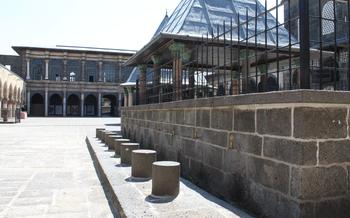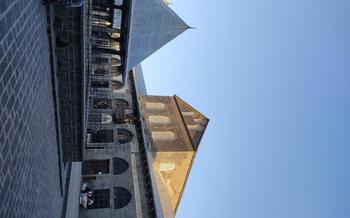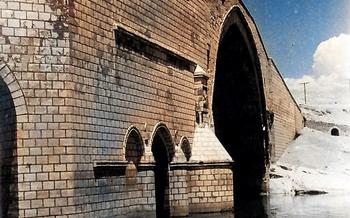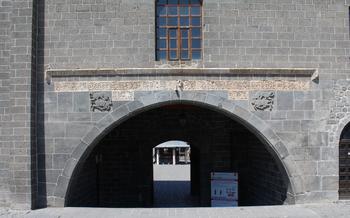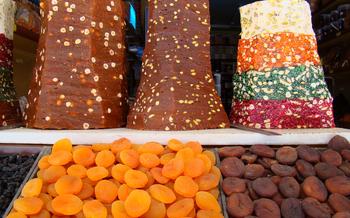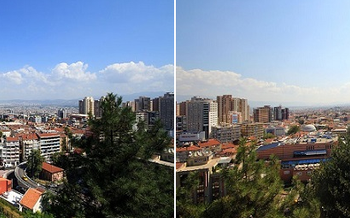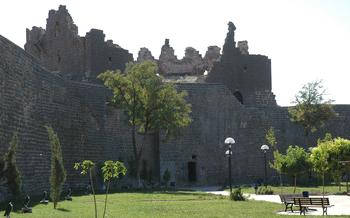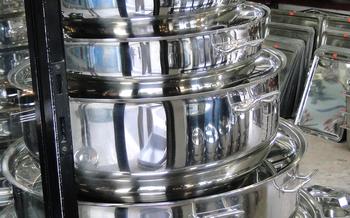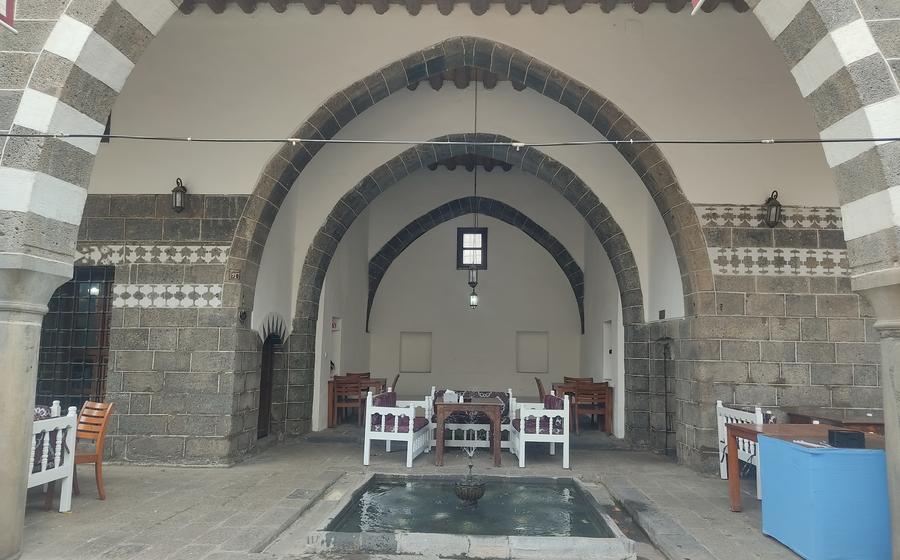
Zinciriye Medrese
- History of the Zinciriye Medrese
- Location of the Zinciriye Medrese
- Visiting the Zinciriye Medrese
- Exploring the Zinciriye Medrese
- Architectural Highlights of the Zinciriye Medrese
- Zinciriye Medrese as a Center of Learning
- The Restoration and Preservation of the Zinciriye Medrese
- The Zinciriye Medrese Museum
- Cultural Events and Activities at the Zinciriye Medrese
- The Zinciriye Medrese as a Symbol of Diyarbakır
- The Zinciriye Medrese in Popular Culture
- Insider Tip
History of the Zinciriye Medrese
Nestled in the heart of Diyarbakır, Turkey, the Zinciriye Medrese stands as a testament to the city's rich history and architectural heritage. This impressive edifice was constructed during the reign of the Artuqid dynasty in the 12th century. It was commissioned by the ruler of the time, Artuk Bey, as a center of Islamic learning and scholarship. The Zinciriye Medrese has played a significant role in the development of Islamic theology and jurisprudence, and it continues to be a symbol of the city's cultural and intellectual legacy. Its architectural design reflects the transitional period in Islamic architecture, showcasing a blend of Seljuk and Anatolian styles. The medrese's intricate carvings and decorative elements are a testament to the skill and artistry of the craftsmen who built it.
Location of the Zinciriye Medrese
The Zinciriye Medrese is situated in the heart of Diyarbakır, Turkey, within the historical Sur district, renowned for its ancient walls and rich cultural heritage. The exact address of the medrese is Zinciriye Medresesi, İçkale, Sur, Diyarbakır, Turkey. To reach the medrese using public transport, visitors can take the T1 tram line and get off at the İçkale stop. The medrese is located just a short walk from the tram stop.
Nearby landmarks and attractions include the iconic Diyarbakır Fortress, with its impressive ramparts and towers, as well as the Grand Mosque of Diyarbakır, one of the oldest mosques in Turkey. Visitors can also explore the nearby Koca Vatan Street, lined with traditional shops and cafes, offering a glimpse into the local culture and cuisine.
The Zinciriye Medrese is easily accessible for people with disabilities, as it features ramps and elevators, ensuring that everyone can enjoy and appreciate its historical significance and architectural beauty.
Visiting the Zinciriye Medrese
The Zinciriye Medrese is open to visitors all year round, except for major Turkish holidays. Opening hours are typically from 9:00 AM to 5:00 PM, but it is always advisable to check the official website or contact the local tourism office for the most up-to-date information.
Admission to the medrese is free of charge, making it an excellent value for budget-minded travelers. Guided tours are available in various languages, including English, Turkish, and Arabic, for a nominal fee. These tours provide an in-depth look at the medrese's history, architecture, and significance, and are highly recommended for those who want to learn more about this fascinating institution.
For those who prefer to explore at their own pace, self-guided tours are also an option. Maps and brochures are available in several languages, providing visitors with the information they need to navigate the medrese and discover its many highlights.
The recommended time for a visit to the Zinciriye Medrese is at least two hours. This will allow you enough time to explore the main courtyard, lecture halls, student residences, library, and mosque, as well as to take in the architectural details and soak up the atmosphere of this historic learning center.
It is important to dress respectfully when visiting the Zinciriye Medrese, as it is still an active place of worship. Shoulders and knees should be covered, and shoes should be removed before entering the mosque. Visitors should also be mindful of the students and scholars who may be studying or praying in the medrese, and refrain from making excessive noise or disruption.
Exploring the Zinciriye Medrese
The Zinciriye Medrese is a complex of buildings that includes the main entrance, courtyard, lecture halls, classrooms, student residences, library, mosque, and prayer hall. The main entrance is adorned with intricate carvings and leads to a spacious courtyard with a central fountain. The courtyard is surrounded by arcades that provide shade and shelter from the sun and rain.
The lecture halls and classrooms are located on the ground floor and are accessible from the courtyard. These rooms are relatively small and simple, but they are well-lit and have good acoustics. The student residences and living quarters are located on the upper floors and are accessed by a narrow staircase. These rooms are also small and simple, but they provide a comfortable and private space for students to live and study.
The library is located on the second floor and contains a collection of over 5,000 manuscripts. These manuscripts cover a wide range of subjects, including Islamic law, theology, philosophy, science, and literature. The library is a valuable resource for scholars and researchers and is open to the public by appointment.
The mosque and prayer hall are located on the third floor and are the most impressive spaces in the medrese. The mosque is decorated with beautiful tiles, carvings, and paintings. The prayer hall is spacious and airy and can accommodate hundreds of worshippers.
Architectural Highlights of the Zinciriye Medrese
The Zinciriye Medrese is a magnificent example of Seljuk architecture, showcasing exquisite craftsmanship and intricate details that reflect the artistic and architectural prowess of the period. Visitors will be captivated by the beautifully carved stone decorations and ornaments that adorn the exterior and interior of the medrese.
The entrance gate, known as the portal, is a masterpiece of architectural design, featuring elaborate carvings and inscriptions that tell the story of the medrese's construction and its founder. Above the portal, the elegant minaret rises towards the sky, its unique shape and intricate patterns symbolizing the spiritual aspirations of the students who studied within the medrese's walls.
The courtyard, the heart of the medrese, is a tranquil oasis surrounded by graceful arcades and a central fountain that adds a serene ambiance to the space. The arcades, supported by slender columns, provide shade and a sheltered walkway for students and visitors alike.
Inside the medrese, the lecture halls and classrooms feature intricate carvings and decorative niches that create an inspiring learning environment. The student residences and living quarters, though simpler in design, provide a glimpse into the daily lives of the scholars who called the medrese their home.
The prayer hall, located at the heart of the medrese, is a sanctuary of spiritual contemplation. Its spacious interior, adorned with intricate tilework and calligraphy, creates a solemn and serene atmosphere conducive to prayer and meditation. The mihrab, the focal point of the prayer hall, is a work of art in itself, featuring intricate carvings and inscriptions that highlight its religious significance.
Zinciriye Medrese as a Center of Learning
The Zinciriye Medrese was a renowned center of learning and scholarship during the Artuqid period. The curriculum included a wide range of subjects, encompassing Islamic theology, law, philosophy, literature, mathematics, astronomy, and medicine. The medrese attracted students from all over the region, who came to study under the tutelage of some of the most renowned scholars and intellectuals of the time.
Among the famous scholars who taught at the Zinciriye Medrese were the polymath Ibn al-Nafis, who made significant contributions to the fields of medicine and anatomy, and the philosopher and theologian Fakhr al-Din al-Razi, who was known for his groundbreaking work in Islamic philosophy and theology. These scholars helped to establish the medrese as a leading center of Islamic scholarship, and their teachings had a profound impact on the development of Islamic thought and culture.
The Zinciriye Medrese also played a crucial role in the transmission of knowledge and culture between the East and the West. It served as a bridge between the Islamic world and the Byzantine Empire, facilitating the exchange of ideas and knowledge between the two civilizations. The medrese's library was particularly renowned for its collection of manuscripts, which included works on a wide range of subjects, including philosophy, science, literature, and history. These manuscripts were meticulously preserved and copied by the students, helping to ensure the survival and dissemination of knowledge across generations.
The Restoration and Preservation of the Zinciriye Medrese
The Zinciriye Medrese has undergone several restoration and preservation projects throughout its history. The first major restoration took place in the 16th century when the medrese was damaged by an earthquake. During this restoration, the minaret and some of the exterior walls were rebuilt. In the 19th century, the medrese was again restored, and the interior was renovated.
The most recent restoration project began in 2000 and was completed in 200This project was carried out by the Turkish Ministry of Culture and Tourism. The restoration involved the repair of the structural damage, the cleaning of the stonework, and the restoration of the original paintwork. The project also included the installation of a new lighting system and the construction of a new visitor center.
The restoration of the Zinciriye Medrese was a complex and challenging process. The workers had to use traditional techniques and materials to ensure that the historical integrity of the medrese was preserved. The project was also complicated by the fact that the medrese is still an active religious site.
Despite the challenges, the restoration project was a success. The Zinciriye Medrese is now in excellent condition and is open to the public. The restoration project has also helped to raise awareness of the medrese's historical and cultural significance.
The Zinciriye Medrese Museum
The Zinciriye Medrese Museum is a fascinating repository of artifacts and exhibits that narrate the story of the medrese's rich history and cultural significance. Visitors can delve into the past as they peruse well-preserved manuscripts, marvel at intricate calligraphy, and examine historical documents that provide a glimpse into the lives of the scholars who once studied and taught within these walls.
The museum's collection is a treasure trove of Islamic art and architecture. Intricate carvings, ornate tiles, and decorative elements from the medrese's original structure are showcased, offering visitors a tangible connection to the craftsmanship and artistry of the era.
Educational displays provide detailed information about the subjects taught at the medrese, the famous scholars associated with it, and the role it played in the development of Islamic scholarship. Visitors can gain insights into the intellectual pursuits and contributions of the medrese's scholars, whose teachings left an indelible mark on Islamic thought.
The Zinciriye Medrese Museum plays a vital role in promoting the cultural and historical heritage of the medrese. Through interactive exhibits, guided tours, and educational programs, the museum engages visitors of all ages, fostering a deeper appreciation for the medrese's legacy and its enduring contributions to Islamic civilization.
Cultural Events and Activities at the Zinciriye Medrese
The Zinciriye Medrese is not just a historical monument but also a vibrant cultural center that hosts various events and activities throughout the year. These events aim to promote the rich cultural heritage of Diyarbakır and provide a platform for local artists, musicians, and performers to showcase their talents.
One of the most popular events held at the medrese is the annual Diyarbakır Culture and Art Festival. This festival brings together artists, musicians, dancers, and artisans from all over the region to celebrate the diverse cultural traditions of Diyarbakır. Visitors can enjoy traditional music and dance performances, art exhibitions, craft demonstrations, and food stalls offering local delicacies.
Throughout the year, the medrese also hosts regular concerts, poetry readings, film screenings, and educational workshops. These events provide a unique opportunity for visitors to learn more about the history, culture, and traditions of Diyarbakır while also enjoying the beautiful surroundings of the medrese.
For those interested in delving deeper into the Islamic heritage of the medrese, there are often guided tours that provide insights into the teachings and practices of the scholars who studied and taught here. These tours offer a fascinating glimpse into the intellectual and spiritual life of the medrese during its heyday.
By hosting these cultural events and activities, the Zinciriye Medrese plays a vital role in preserving and promoting the cultural heritage of Diyarbakır. It is a place where history, culture, and community come together to create a vibrant and dynamic space that is both educational and entertaining.
The Zinciriye Medrese as a Symbol of Diyarbakır
The Zinciriye Medrese holds a profound historical and cultural significance for the city of Diyarbakır. Standing as a testament to the region's rich architectural heritage, the medrese has become an iconic landmark and a symbol of Diyarbakır's identity. For centuries, it has been a center of Islamic learning and scholarship, attracting students and scholars from across the region. Its majestic architecture, intricate carvings, and serene atmosphere have left an indelible mark on the city's cultural landscape.
The medrese's enduring legacy is deeply intertwined with the history and traditions of Diyarbakır. It has played a pivotal role in shaping the city's intellectual and spiritual development, fostering a vibrant community of scholars and thinkers. The medrese's teachings have influenced generations of students, contributing to the city's rich cultural tapestry.
Beyond its educational significance, the Zinciriye Medrese has also become a symbol of Diyarbakır's resilience and diversity. Having withstood the test of time and various historical upheavals, the medrese stands as a testament to the city's ability to preserve its heritage amidst adversity. Its architectural grandeur and historical importance have made it a source of pride for the people of Diyarbakır, reflecting their deep-rooted connection to their cultural roots.
The Zinciriye Medrese in Popular Culture
The Zinciriye Medrese has become a popular tourist destination in recent years, attracting visitors from all over the world who are drawn to its historical significance, architectural beauty, and cultural heritage. The medrese has been featured in numerous travel guides and magazines, and has been used as a backdrop for events and celebrations such as weddings, concerts, and fashion shows. The medrese has also been promoted through social media and tourism campaigns, which have helped to raise awareness of this hidden gem and attract even more visitors.
The increasing popularity of the Zinciriye Medrese in popular culture has had a positive impact on its preservation and promotion. The medrese has been restored and renovated to its former glory, and is now open to the public as a museum. The museum houses a collection of artifacts and exhibits that tell the story of the medrese's history, architecture, and cultural significance. The medrese also hosts a variety of educational programs and events, which help to promote its cultural heritage and encourage visitors to learn more about its rich history.
Insider Tip
Zinciriye Medrese is best enjoyed in the early morning or late afternoon when the crowds are fewer, allowing you to fully appreciate its serene ambiance. For some quiet contemplation, head to the prayer hall, where you can find a peaceful corner to reflect and soak in the spiritual vibes.
Don't miss the hidden gem of the medrese – the rooftop terrace. Climb the narrow staircase to access this secluded spot and be rewarded with panoramic views of the city, including the iconic Diyarbakır Castle. It's the perfect place to capture stunning photos and take a break from exploring.
After your visit, satisfy your taste buds with the local delicacies at Cigerhun and Mırra, two renowned restaurants near the medrese. Cigerhun is famous for its grilled lamb liver, a local specialty, while Mırra offers a delectable selection of traditional Turkish dishes.
To capture the essence of Zinciriye Medrese, play around with different angles and lighting. Experiment with wide shots to showcase the grandeur of the architecture and close-ups to highlight the intricate details. Don't forget to include the vibrant energy of the surrounding streets in your photos to create a lively and authentic portrayal of this historical gem.
